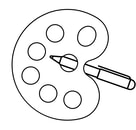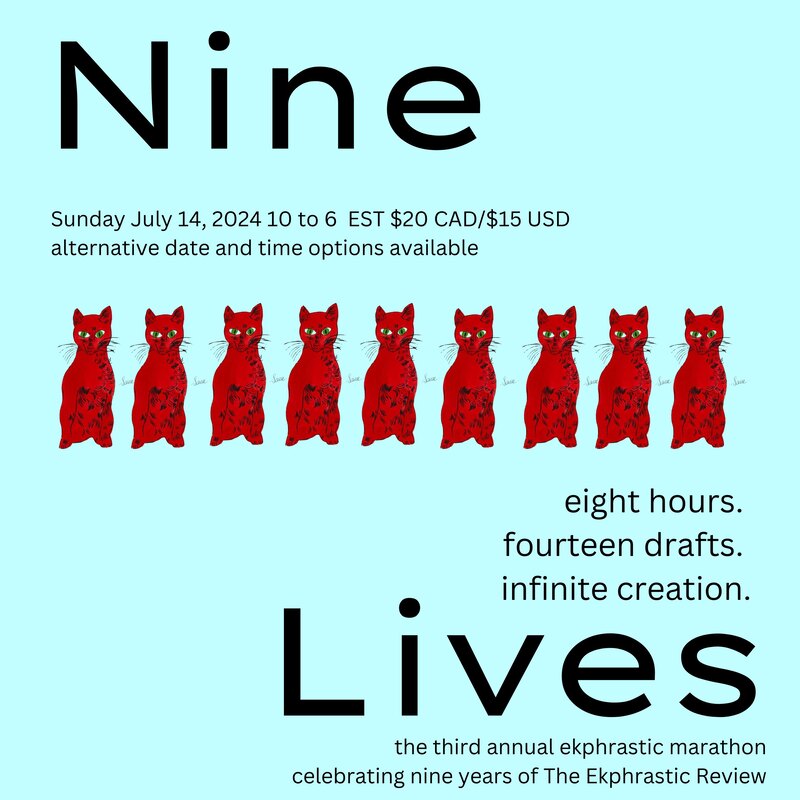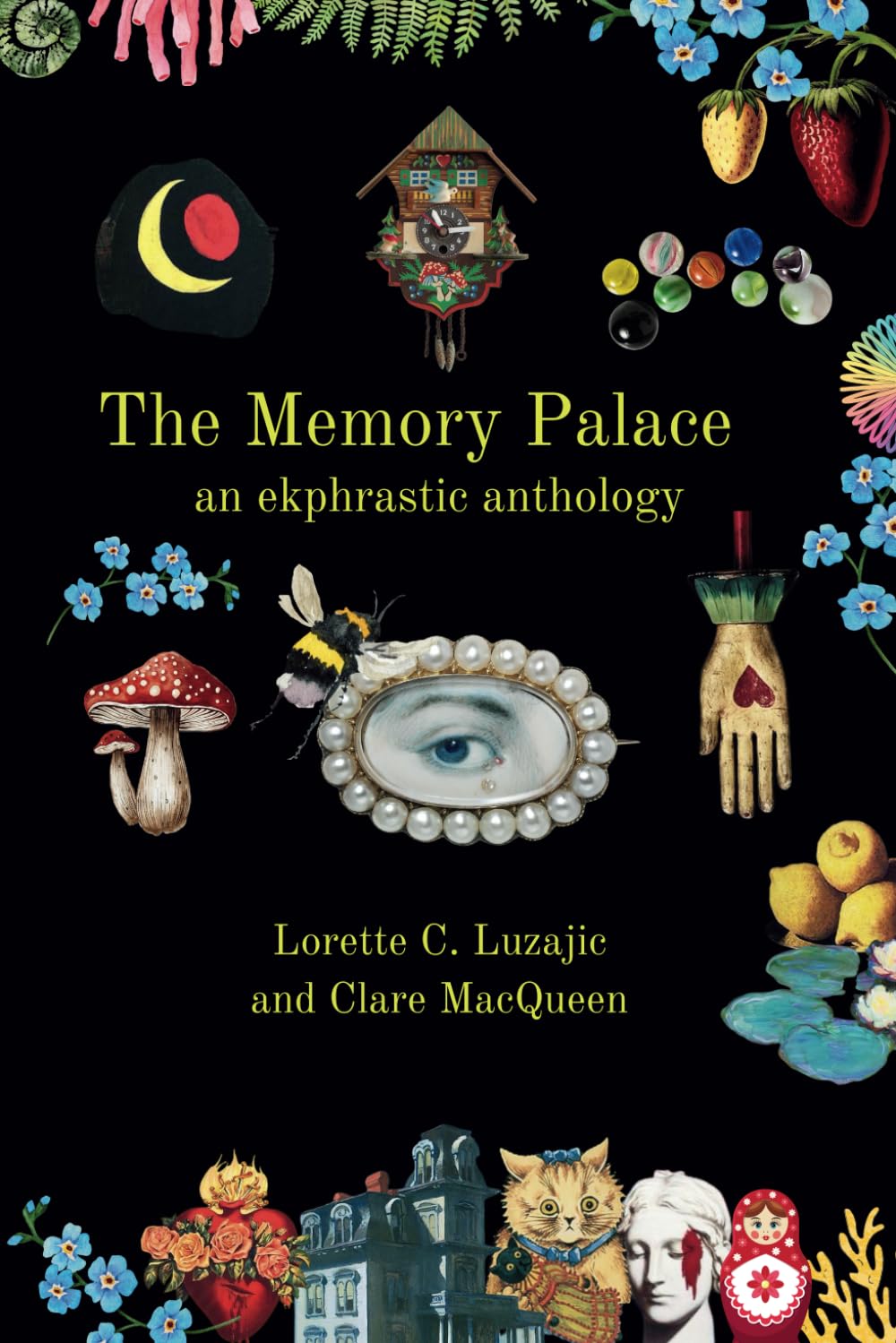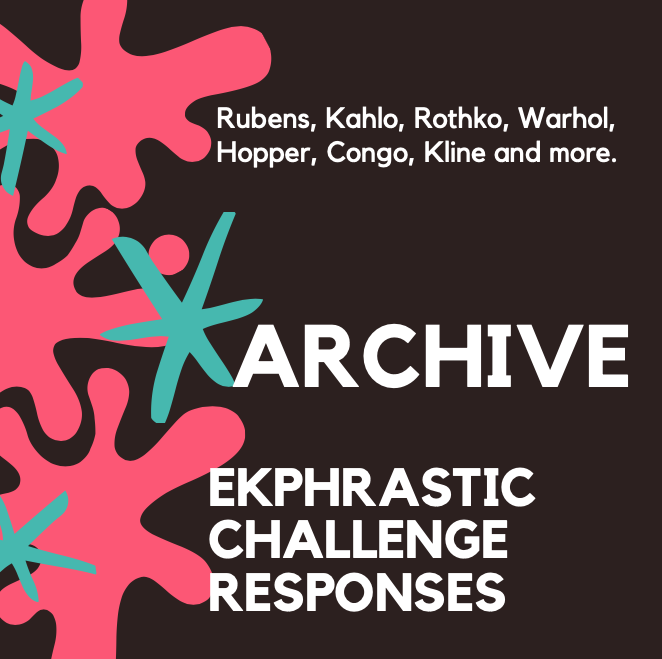|
In Memoriam: Heather Sarabia 3.1.88- 7.12.24. Our deepest condolences to Heather's loved ones. We are honoured to have published Heather's poems, and to publish this one in her memory. ** Flow Very sure things flow through the mind like water flows through the strong current of a stormy ocean. I lose a lot in the spray of the wave and need to wait until it crashes before I can get control of the flow. Be aware of where everyone flows then you can meet them in calmer waters. Heather Sarabia Heather Sarabia is a visual artist and an emerging but long-time writer. She lives in Madison, WI and is on the autism spectrum. Despite being nonverbal, she is a prolific writer and poet, typing out poems and prose with assistance. Her work has recently appeared in The Ekphrastic Review. More of her artwork can be found at https://www.artworking.org/heather-sarabia. ** Read Heather's poem, "Emptiness," here (scroll down a bit): https://www.ekphrastic.net/the-ekphrastic-challenges/gustave-guillaumet-ekphrastic-writing-responses Read Heather's poem "Memories of a Forgotten Paris," here (scroll down quite a bit): https://www.ekphrastic.net/the-ekphrastic-challenges/camille-pissarro-ekphrastic-writing-responses
0 Comments
Birds of Perugia Recovering after a year in a prisoner-of-war camp, he slowly regained strength, but visions persisted. He abandoned the silk business of his father, switched from feasts to fasts. Merchants saw him talking to birds and that was it – the gold he inherited was dust from country roads and sunshowers in random fields. Something odd and radiant happened at the woodland edge outside Bevagna, where multitudes of “sisters-birds” stretched their necks and extended wings, as they listened to him praising the Giver of carefree flight. Not until his last word did birds start rising, as if endowed with the reason. Of course, it’s fiction, but what would you know with a brain that lets you see this golden-leaf-on-wood of October in a spectrum even narrower than a bird’s? Elina Petrova Until 2007 Elina Petrova lived in Ukraine and worked in engineering management. Now she assists in a Houston law firm and enjoys writing in her rose garden. Elina published two poetry books in English (Aching Miracle, 2015, and Desert Candles, 2019) after the first one in her native Russian language. Her poems have appeared in Notre Dame Review, Chicago Quarterly Review, Texas and California Reviews, North Dakota Quarterly, and elsewhere. A film presenting her poem at the 2023 Miami Chroma Film Festival won in the category Best Cinematic Poetry. Our Past is the Emptied Café Terrace Our past is the emptied café terrace: Mid-September, Arles 1888. The North-eastern corner of the Place du Forum. Now there is a painting of night, without night. Through constellations captured in time, On a sky’s trodden contours, Her gaze scans across the scene For figures calling last-orders. Glass darkening the internal vibrancy, Its print overtook our Oregon home, Bracing floral-fringed lampshades –assured traces of Art Noveau. Its being in time shading our own: October tail-end of an Indian-summer Remembering an unplaced bar On a Prague street corner, Awaiting the last bus to come –to deliver us back To the familiar hedged shadows Of an emptying campsite. Another, smaller, terraced-print hangs Out of place in the elsewhere of now. A poorly-framed charity shop relic, Past belonging to the unhoused. You watch it float above the roof, And vacant rooms of your dollhouse, Wherein a world might be revealed By the removal of an external wall. Peter Kelly Peter Kelly teaches and researches poetry in the ancient and modern worlds in Princeton University. He is originally from Galway, Ireland and much of his work considers ideas of place and displacement in shifting environments. He is the editor of a collected volume on Ekphrasis, which brings together creative and academic essays on the connections between the use of ekphrasis in ancient Greece and Rome, and contemporary poetry. The Fantastic Wheel As I was crossing town today, my feet fused into one big wheel. It made my journey easier. True, I rumbled on uneven pavement, but at least I didn’t stumble and now I zip past boys on bicycles delivering Instagrams, though I prefer to move at the pace of, let’s say, a croquet ball wobbling through tall grass, for this fantastic wheel allows me to catch glimpses of the past: my mother as she walked to school, warming her hands with roasted chestnuts in her pockets. One of the few stories of hers that didn’t feature her bully brother. And now I see my father and his brother. They stand in dueling pose, whacking each other with sticks. Even at the age of ninety, Dad gazed into the distance and said, I beat him, didn’t I? Meaning, he’d managed to live longer. And now I see my brother, changing a flat tire that time his back was bad. What made him persist? The fantastic wheel helps me to see simple moments in the lives of complicated people. Not to dwell in the past, but to keep rolling toward a better understanding. Mind you, the present holds delights. That secret smile inside my grandson’s eyes. Don’t let me move too fast. I want to pay attention. Learning to Play To make audible the tunes that rise inside you, lean against a rocky crag. Absorb melodies embedded in earth’s libraries of sand and clay. You will need a few molten rocks to spark the air, a scrim of fine ash to alter the view. Then build, note by note, story by story, a scaffolding. Climb toward sky. Love the clouds, but also love the grass. Practical Magic The floorboards of our boarding school grew thin and pocked from the impact of girls turned stiff and upholstered, ruled, as we were by shipwrecked women paid pennies to watch over young lives on the cusp of making love, not war. Oh there was Miss C who hummed as she prowled the halls, permed head thrust forward, sniffing for trouble. Mrs. G, widow of a Russian count, or so she said, told stories of spies, and owned only two brown sweaters. Miss L’s trembling hands barely managed a fork. Into my room she came one night, breathing whiskey, whispering Honey. And what of Miss H, our long-dead founder, who took her students to sun-flecked Italy? Girls should be encouraged to experience the fullness of life. Come back and haunt us, Miss H. We need you here. It was late, my radio turned low. And suddenly, the doors to my fusty armoire blew open, delivered me clouds. Cirrus and cumulus (we had been taught the names of things) and I clambered aboard and sailed out of the school, sailed over meadows, over rows of growing things. I didn’t know their names but I could feel how their stems drank water, how the tiny hairs on the underside of leaves protected them. I touched down on a moonlit road and danced with my shadow. How lovely the world was, and lonely. I returned to my cell. Vowed to become more cello than chair. I Wanted to Fly I made a pair of wings cut from the yellow coat I wore to church, but the wings were too heavy. They pinched my shoulders. I gave them to a boy, then hunkered down in a courtyard and turned the crank of a hurdy-gurdy, the only instrument I knew how to play, to celebrate his lift-off. He flapped those wings and soared. I didn’t think to ask why the boy could fly, and I could not. What I Carry The head of a man I once knew, to be dropped into the nearest bin, and a basket of grievances no longer useful—tempting, also, to discard the mask I wear like glasses slung about my neck, and also the cloak I’ve worn for years, wool woven from ancestors’ sheep that grazed a dirt-poor hillside. The cowl bunches around my mouth, makes it hard to speak, but I have spoken enough for one day. The sun is out. I will turn my back on brick and run to the mossed woods, free of mask and cloak. Amy Gordon Amy Gordon taught drama to middle school kids for many years. Her collection of poems, Leaf Town, won the 2023 Slate Roof chapbook prize. She lives in Western Massachusetts overlooking the Connecticut River. Reflections on Helen Frankenthaler’s Mauve District it is a pale purple uneven territory created by an abstract dripper mapping the square canvas with permanent restrictions to legally dominate the quadratic space exclusively for neglected plum looking pigments retreating from creamy/white domination that arrogantly refuse to variegate into a universal multicolored municipality tinted with rainbow brush strokes & darker hues which fuel artistic energy while burnished gold flowing like rivulets guard the whitish border preventing blues & reds from merging into mauve preferring distinct segregation rather than blended integration Davidson Garrett This was first published by Sensations Magazine. Davidson Garrett is a poet, actor, and former New York City yellow taxi driver who lives in Manhattan. He is the author of two poetry collections, King Lear of the Taci, published by Advent Purple Press, and Arias of a Rhapsodic Spirit, published by Kelsay Books. www.davidsongarrett.com Seated Draped Figure Pyramidal, your self-hood falls– slides down your curved and parted hair, rolling over shoulder hip and thigh to meet in folded fabric at your feet. To gaze… to tilt… I too am falling, that sideways-dipping motion pulls me down to thump, heavy, on a seat of marble. My body ripples, coated in a silken gown and soothed by the softest stone. Who calls? A name rings out and mine is the arm that lifts. Suspends. Considers. Draped and Duncan-like, I sit, sensing some invasion sweet with kinship. I have stolen her body, your pose, the space of four hundred years pressed flat like thin red chalk lines tinged with moss. Pyramidal, my self-hood falls– settles. I stand and leave your gallery, still tilting, considering, silk residue on my skin and marble underfoot. Maya Slocum Maya Slocum is a New-England based writer, dancer, and ocean lover. She sees her poetry as an extension of her lived experience, and often draws on her relationships with humans, movement, and the natural world as starting points for her work. The Basket of Apples If there were snakes that day they let us be, in peace to wade the sea of meadow grass and fern. We found the orchard creekside, overgrown, the old church rotting and one by one the apples. Seedlings sprouting from the dung of mule deer, a narrow path mapping the sweetest fruit. We didn’t plan it, didn’t ask to be born on this tilted plane, for river shadows pulling everything we love from the sky. The lower branches already cleaned, I pointed, shielding my eyes as you climbed the rustling fabric of the leaves, toward the perfect Blue Pearmain, and when it gave, leaves and all, a dozen more rained down, screeching kestrels in the cottonwood. Our laughter playing off the marble cliffs became the sound of water, the colours of the trees. Kelly Houle This poem was first published in Radar Poetry. Kelly Houle’s poems have been published in Alba, CALYX, Connecticut River Review, Crab Orchard Review, Kenyon Review, Radar Poetry, Sequestrum, and others. She was a finalist for the Arts and Letters ‘Unclassifiable’ contest and winner of a 2023 Vivian Shipley Award. She is also a painter. Choosing the Memory of Her After Suzanne Valadon’s The Blue Room Cigarette held in pink lips. Hand on thigh. Relaxed, she looks outside the frame, perhaps at a lover, another woman, in my dreams. Books lay at her feet. The woman is large and beautiful. Looking at her makes me want to love my body more. She looks soft and kind. She lounges, posing as if she were naked, but she is cloaked in pink and white and green. Strong eyebrows frame her face. Her pale skin flushed. Portraiture as intimacy, staring at a body, lingering on each inch of skin. I sense tender stares behind the frame. To lounge as a fat person sometimes feels like a luxury. Thoughts of laziness flood my brain, but I persist to stay present in my restful joy. Paintings like this make me want to love myself. I wonder if others look at my body the way I look at this woman’s body. It feels impossible for a moment, but I look at her again and just want to stare at her for hours, her belly, her thighs, her arms. She is large, and she is beautiful. I hope one day someone will say the same of me. Elena Macdonald Elena Macdonald (they/she) is a writer from Northern Virginia. They are a current MFA candidate in nonfiction at George Mason University, and they received their BFA in Creative Writing from GMU. Elena is also the website editor for Phoebe Journal, and they read for Phoebe Journal, So to Speak Journal, Poetry Daily, and In Short: A Journal of Flash Nonfiction. In their free time, Elena loves to cook and dabble in crafts. Sometimes It Helps to Squint Our eyes can’t help but be fooled by White’s Illusion grey stripes glued to white, are brighter than grey stripes flanked by black. An Agnes Martin tree trick. Line after line, we strive to make mean, mean anything, anything at all. I can not tolerate just being, wear my buff and navy Breton shirt to look sophisticated. My jalousie windows must open onto something greater than myself. Pampas grass, lemongrass, sharp, long blades of green. Don’t touch the spaces between, interstitial danger, razor-edged as arthritis. Real life abhors friction. The drag of a blade’s edge against the skin of its neighbour. Christa Fairbrother Christa Fairbrother, MA, has had poetry in Arc Poetry, Pleiades, Stoneboat, and others. She’s been a resident with Sundress Academy for the Arts and the Bethany Arts Community. Currently, she’s Gulfport, Florida’s poet laureate and she’s been a Pushcart Prize nominee. When her face is not stuffed into a book, she loves tea and avocados. Connect with her at www.christfairbrotherwrites.com. Sense of Stevedores Observing Men of the Docks by George Bellows To hear a painting before you see it. Through clang and clamour I gesture to touch, feet taken by sodden bank; there’s an industry in questions like how many? me or him? One man's slough. Darkly, he separates to seek other opportunities, or else to shatter in his own coat in a city windy and new. A skin down, he's open to the sentiment of letters home. A rain that feels like falling sulphur begins as he walks off his pride, shedding it between buildings uptown before returning, small enough now to fit between brushstrokes, and men asking of headers how many? me or him? At last, I see the painting and bright colour where there needn’t be. Ewen Glass Ewen (he/him) is a Northern Irish poet who lives in England with two dogs, a tortoise and lots of self-doubt; on a given day, any or all of these can be snapping at his heels. His work has appeared or is forthcoming in HAD, Bridge Eight, Poetry Scotland, Gordon Square Review and elsewhere. On socials (and in real life) he is pretty much ewenglass everywhere. |
The Ekphrastic Review
COOKIES/PRIVACY
This site uses cookies to deliver your best navigation experience this time and next. Continuing here means you consent to cookies. Thank you. Join us on Facebook:
July 2024
|

















